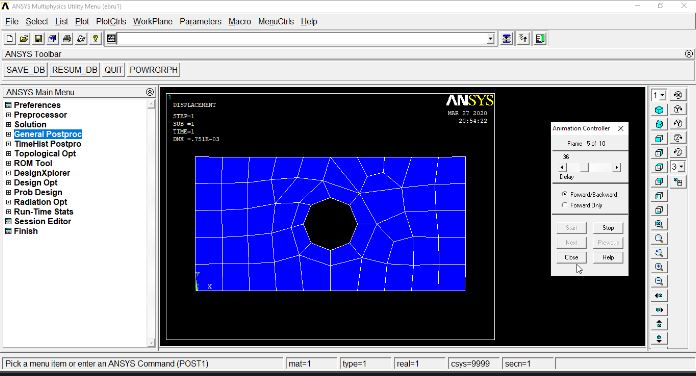Yeni bir analiz türü denediğinizde, sonuçları karşılaştırmak için bir şeye ihtiyacınız vardır (yani analitik çözüm veya deneysel veriler). Bu şekilde, doğru analiz türünü, birimleri, ölçek faktörlerini vb. aldığınızdan emin olmalısınız. Bu problem için kullanılacak basitleştirilmiş versiyon, aşağıdaki şekilde gösterilen bir deliği olan düz dikdörtgen bir plakadır. Bu örnek için, kalınlığı olan bir düzlem gerilim elemanına ihtiyacımız var. Basınç plakanın yüzeyi boyunca eşittir. Basınç, plakanın yüzeyinden uzaklaşmaktadır ve bu nedenle negatif basınç olarak tanımlanmaktadır. Maksimum sapma plakanın üst tarafında gerçekleşir ve plakadaki deliğin etkilerini ihmal ederek (yani düz bir plaka) 0.001 mm olarak hesaplanmıştır. Maksimum gerilme, plakadaki deliğin üstünde ve altında meydana gelir. Bu noktada, nihai sonucun yakınsak olup olmadığını bulmamız gerekir. Bunu, örgü elemanının boyutunu değiştirirken belirli düğümlerdeki sapma ve gerilime bakarak yapacağız. Maksimum stres noktası için analitik bir çözümümüz olduğundan, bu noktada stresi kontrol edeceğiz. Ağdaki eleman sayısı arttıkça (yani, eleman kenarı uzunluğu azaldıkça), değerler nihai bir çözeltiye yaklaşır. Bu nedenle, ANSYS kullanan sonuçların doğrulama modeli için uygun olduğu belirlenmiştir.
Sevgilerle.
When you try a new type of analysis, you need something to compare the results (i.e. analytical solution or experimental data). In this way, you can determine the correct type of analysis, units, scale factors, etc. you have to make sure you get it. The simplified version to be used for this problem is a flat rectangular plate with a hole shown in the figure below. For this example, we need a plane tension element with a thickness. The pressure is equal across the surface of the plate. The pressure moves away from the surface of the plate and is therefore defined as negative pressure. The maximum deviation occurs at the top of the plate and is calculated as 0.001 mm, neglecting the effects of the hole in the plate (i.e. a flat plate). Maximum stress occurs above and below the hole in the plate. At this point, we need to find out if the final result is convergent. We will do this by looking at the deviation and tension in certain nodes when changing the size of the knitting element. Since we have an analytical solution for the maximum stress point, we will check the stress at this point. As the number of elements in the network increases (i.e., the length of the element edge decreases), the values approach a final solution. Therefore, it is determined that the results using ANSYS are suitable for the validation model.

